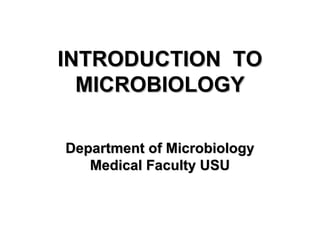
Introduction to Microbiology: Bacteria, Viruses, and Other Microbes
- 1. INTRODUCTION TOINTRODUCTION TO MICROBIOLOGYMICROBIOLOGY Department of MicrobiologyDepartment of Microbiology Medical Faculty USUMedical Faculty USU
- 2. Spesific Learning Objectives 1. Menjelaskan asal usul mikroorganisme 2. Menyebutkan tokoh/perintis dalam bidang mikrobiologi 3. Menyebutkan kaidah mikroba sebagai penyebab penyakit (Postulat Koch) 4. Menjelaskan perbedaan dan perbandingan sifat virus, bakteri, jamur, chlamydia dan ricketsia
- 3. REFERENCES JAWETZ, MELNICK & ADELBERG’S MEDICAL MICROBIOLOGY, 24TH EDITION by Geo. F. Brooks, Karen C. Carroll, Janet S. Butel, and Stephen A. Morse, McGraw-Hill, 2007. MIKROBIOLOGI KEDOKTERAN, Edisi Revisi, Pengarang Staf Pengajar FK UI, Binarupa Aksara.
- 4. REFERENCES Lippincott’s Illustrated Reviews Microbiology 2nd edition by Richard A. Harvey, Pamela C. Champe, Bruce D. Fisher, 2007, Lippincott Williams & Wilkins. MEDICAL MICROBIOLOGY by FH Kayser, K.A. Bienz, J. Eckert, R.M.Zinkernagel, Thieme, 2005.
- 5. Microbiology defined ‘The study of microorganisms, where the individual cells of the 'microbe' can't be seen by the unaided human eye' That is, we need to use specialized detection systems-usually optical instruments termed microscopes. There are 2 main type main types of microscopes in use: - Bright field microscope resolution about 0.2µm - Electron microscope resolution about 100 times greater
- 6. What is microbiology? Bacteriology Virology Mycology Immunology Genetics
- 8. Virus Contain only one type of nucleic acid, either DNA or RNA No enzymatic energy producing system No protein synthesizing apparatus Force infected host cells to synthesize virus particles
- 9. Comparison of prokaryotic and eukaryotic cells Characteristic Prokaryotic cells Eukaryotic cells Chromosome Single, circular Multiple Nucleus No nuclear membrane or nucleoli Membrane-bound, nuceoli present Membrane-bound organelles Not present Present (examples include mitochondria and endoplasmic reticulum) Cell wall Usually present, many contain peptidoglycan Present in plant cells, no peptidoglycan Plasma membrane No carbohydrates, most lack sterols Sterol and carbohydrates present Ribosome 70S 80S Average size 0,2-2 µm in diameter 10-100 µm in diameter Replication Binary fission Budding or mitosis
- 10. Procaryotes Procaryotes (refers mainly to the bacteria) No nucleus Generally circular DNA genome +/- cell wall Can have extrasomal DNA DNA without introns Haploid (chromosome) Binary division
- 11. BACTERIA Classic bacteria. Reproduce asexually by binary transverse fission. Do not possess the nucleus typical of eucarya. The cell walls of these organisms are rigid (with some exceptions, e.g., the mycoplasma).
- 12. ATYPICAL BACTERIA Chlamydiae Obligate intracellular parasites that are able to reproduce in certain human cells only. Found in two stages: the infectious, nonreproductive particles called elementary bodies (0.3 lm) and the noninfectious, intracytoplasmic, reproductive forms known as initial (or reticulate) bodies (1 lm).
- 13. ATYPICAL BACTERIA Rickettsiae Obligate intracellular parasites. Rodshaped to coccoid. Reproduce by binary transverse fission. The diameter of the individual cell is from 0.3–1 lm.
- 14. Eucaryotes Eucaryotes (include fungi, protozoa, helminth) Have nucleus Other membrane organelles Diploid chromosomes Mitotic & meiotic division Have introns and exons
- 15. In clinical microbiology we have interest in both Bacteria (procaryotic) Eg Staph sp, Strep sp, E.coli, Mycoplasma sp Fungi (eucaryotic) Eg Candida sp (single celled yeast), Aspergillus sp (multicelled) Parasites (eucaryotic) Eg Giardia lamblia, Plasmodium sp (malaria) Viruses Eg HIV, HBV, HBC, Rubella, Herpes (EBV, VZ, HSV)
- 16. A little History Before about 1650 philosophers believed in “SPONTANEOUS GENERATION” Significant discoveries altered this thinking.
- 17. Some of the key players were: ANTON van LEEUWENHOEK, 1674 Mid 17th Century probably 1st to observe bacteria under magnification Although Robert Hooke first to observe microbes through magnification- It’s thought he saw protozoa(larger cells such as amoebae)
- 19. Edward Jenner, 1796 First successful vaccination Relationship of cowpox to smallpox Smallpox (virus) 30-40% mortality Viremia followed by death Last naturally occurring case in Africa, 1976 Role of WHO in smallpox eradication Possible because humans are the only smallpox host.
- 20. LOUIS PASTEUR: Demonstrated by the use of sterile media that microbes were in fact present in air And that air does not create microbes Used broths in flasks and ‘S’ funneled microbial trap experiments Fermentation Pasteurization
- 22. Joseph LISTER (1860) Adopted the use of 'aseptic' techniques which lead to its general adoption
- 23. ROBERT KOCH (1876) Proved beyond doubt that specific organisms were the cause of specific infectious diseases. Experiments with the very lethal disease (especially of cattle) anthrax Koch and wife 1905-Nobel Prize
- 24. KOCH’S POSTULATES 1. The same 'pathogen' must be present in every case of the disease 2. The pathogen must be isolated from the diseased host and grown in pure culture 3. The pathogen when inoculated into a susceptible uninfected host causes the disease 4. The pathogen must be re-isolated in pure culture from the inoculated animal
- 25. Griffith – 1928 – Experiment to determine which part of a pneumococcus bacteria caused the disease. 1944 – Genetic material is DNA, not the capsule, not the cytoplasm. Provided the groundwork for Avery and McLeod’s definitive work, as well as for Watson and Crick (1953) DNA Structure Fleming – 1929 – Penicillin (beta lactam ring in outer layer of a bacteria is inhibited, making cell wall synthesis impossible)